Parent-Teacher Organization initiatives designed for the elementary school level encompass a broad range of activities and programs intended to enrich the student experience. Examples include fundraising events like book fairs or carnivals, community-building activities such as movie nights or family picnics, and educational enhancements like author visits or science fairs. These initiatives can also involve supporting teachers with classroom supplies or volunteer assistance.
Strong parent-teacher partnerships are vital for a thriving school environment. These collaborative efforts can lead to improved student academic performance, increased teacher morale, and a stronger sense of community. Historically, parent involvement has played a crucial role in shaping educational landscapes, advocating for student needs, and providing valuable resources to schools. A robust and active parent-teacher partnership fosters a supportive ecosystem where students, teachers, and parents work together toward shared goals.
This article will explore various strategies and examples of successful parent-teacher initiatives that can be implemented in elementary schools, covering topics such as fundraising, community engagement, and academic enrichment. It will also delve into practical advice on organizing, managing, and promoting these initiatives to maximize their impact.
Tips for Successful Parent-Teacher Initiatives
Effective parent-teacher collaboration requires careful planning and execution. The following tips offer guidance for developing and implementing successful initiatives within elementary school settings.
Tip 1: Clearly Defined Goals: Establish specific, measurable, achievable, relevant, and time-bound objectives for each initiative. A clearly articulated goal, such as raising a specific amount for new playground equipment or increasing family participation in school events by a certain percentage, provides direction and allows for progress tracking.
Tip 2: Diverse Fundraising Strategies: Explore a variety of fundraising approaches beyond traditional methods. Consider options like online donation platforms, restaurant partnerships, or themed auction events. Diversification can broaden reach and increase revenue potential.
Tip 3: Inclusive Community Building: Design activities that cater to diverse family backgrounds and interests. Offer events that accommodate various schedules and cultural preferences. Inclusivity fosters a welcoming environment and strengthens school community bonds.
Tip 4: Effective Communication: Maintain open and consistent communication channels between parents, teachers, and school administration. Utilize tools like newsletters, social media platforms, and dedicated websites to share updates and important information. Transparency builds trust and encourages participation.
Tip 5: Teacher Appreciation Initiatives: Implement programs that recognize and value the contributions of teachers. Simple gestures like providing classroom supplies, organizing staff appreciation lunches, or offering small tokens of gratitude can significantly boost morale.
Tip 6: Volunteer Coordination: Develop a streamlined system for managing volunteers. Clearly define roles, provide necessary training, and offer flexible scheduling options. Efficient volunteer coordination maximizes resources and ensures smooth event execution.
Tip 7: Student Involvement: Engage students in age-appropriate ways in planning and executing initiatives. This fosters a sense of ownership and empowers them to contribute to their school community.
By implementing these strategies, schools can cultivate thriving parent-teacher partnerships that enrich the educational experience for all stakeholders. These collaborative efforts contribute to a positive and supportive school environment where students can thrive academically and socially.
These tips provide a foundation for building strong parent-teacher collaborations. The following section will offer concluding thoughts and emphasize the long-term benefits of these partnerships.
1. Fundraising
Fundraising constitutes a critical component of Parent-Teacher Organization initiatives within elementary schools. A successful fundraising program provides essential financial resources that directly impact the quality of education and student experiences. These funds can support a wide range of school improvements, from purchasing new technology and library books to enhancing playground facilities and supporting extracurricular activities. The ability to secure necessary funding often determines whether a school can implement specific programs or purchase needed resources. For example, fundraising efforts might enable a school to purchase new computers for a computer lab, providing students with access to updated technology and enhancing their learning opportunities. Similarly, funds raised could support field trips, offering enriching experiences outside the classroom that broaden students perspectives.
Effective fundraising requires careful planning and execution. Strategies can range from traditional events like bake sales and car washes to more innovative approaches such as online crowdfunding campaigns and silent auctions. Selecting appropriate fundraising methods depends on the school communitys demographics and resources. A school in a predominantly online community might find greater success with virtual fundraising campaigns, while a school with strong local business partnerships might benefit from collaborative fundraising initiatives. Understanding the community context is crucial for maximizing fundraising potential. For example, a school with a strong artistic community might hold a student art auction, while a school with a large parent population working in tech might solicit donations from local tech companies. Tailoring fundraising strategies to the specific community context increases the likelihood of success.
Successful fundraising not only generates financial resources but also strengthens the school community. Participating in fundraising activities fosters a sense of shared purpose and builds stronger relationships between parents, teachers, and students. Working together towards a common goal creates a more cohesive and supportive school environment. While financial gain is the primary objective, the intangible benefits of community building and increased parent involvement contribute significantly to a positive school culture. Challenges such as donor fatigue and limited resources can arise; however, careful planning, transparent communication, and creative fundraising strategies can mitigate these issues. Ultimately, effective fundraising plays a vital role in enhancing educational opportunities and creating a thriving school environment.
2. Community Building
Community building represents a crucial aspect of successful Parent-Teacher Organization initiatives. A strong sense of community fosters a supportive and engaging learning environment where students, teachers, and families feel connected and valued. This sense of belonging enhances student well-being, promotes parental involvement, and strengthens school-family partnerships. A cohesive school community provides a foundation for academic success and overall student development.
- Shared Experiences:
Creating opportunities for shared experiences strengthens connections within the school community. Events such as school picnics, movie nights, or talent shows provide informal settings for families to interact and build relationships. These shared experiences foster a sense of belonging and create positive memories associated with the school. For example, a multicultural potluck dinner can celebrate the diversity within the school community while providing an opportunity for families to share their cultural traditions.
- Volunteer Opportunities:
Providing diverse volunteer opportunities enables parents and community members to actively contribute to the school environment. Volunteering in classrooms, assisting with school events, or participating in fundraising activities allows individuals to invest their time and talents in supporting student learning and school improvement. For example, parents can volunteer to read with students, help organize a school garden, or assist with library operations. These opportunities not only benefit the school but also strengthen the connection between families and the school community.
- Open Communication:
Maintaining open and consistent communication channels is essential for fostering a strong sense of community. Regular newsletters, school websites, and social media platforms provide avenues for sharing information about school events, student achievements, and important updates. Transparent communication builds trust and ensures that all stakeholders feel informed and involved. For example, a school newsletter might highlight upcoming events, student artwork, or teacher spotlights, fostering a sense of connection and shared pride in the school community.
- Inclusive Practices:
Embracing inclusive practices ensures that all families feel welcome and respected within the school community. Organizing events that cater to diverse cultural backgrounds, family structures, and individual needs creates a sense of belonging for everyone. For example, offering multilingual resources, providing accessibility accommodations, and celebrating a wide range of cultural holidays demonstrates a commitment to inclusivity and strengthens the bonds within the school community.
By fostering a strong sense of community through shared experiences, volunteer opportunities, open communication, and inclusive practices, Parent-Teacher Organizations can create a supportive and welcoming environment that benefits all members of the school community. This sense of connection enhances student learning, strengthens family engagement, and promotes a positive school culture. Ultimately, a strong school community contributes significantly to the success and well-being of students, teachers, and families alike.
3. Teacher Appreciation
Teacher appreciation plays a vital role in successful Parent-Teacher Organization initiatives within elementary schools. Recognizing and valuing the contributions of teachers strengthens school-family partnerships, boosts teacher morale, and creates a positive school climate. Demonstrating gratitude for the dedication and hard work of teachers fosters a supportive environment where educators feel valued and respected.
- Tangible Expressions of Gratitude
Providing tangible expressions of gratitude demonstrates appreciation in concrete ways. Small gifts, such as personalized stationery, classroom supplies, or gift cards, convey thoughtful recognition of teachers’ efforts. Organizing staff appreciation lunches or providing catered meals during parent-teacher conferences offers practical support and acknowledges the demands on teachers’ time. These gestures, while simple, communicate genuine appreciation and contribute to a positive school culture.
- Verbal Acknowledgement and Recognition
Verbal acknowledgement and public recognition of teachers’ contributions reinforce their value within the school community. Highlighting individual teacher accomplishments during school assemblies, featuring teacher profiles in school newsletters, or sharing positive feedback from parents and students demonstrates appreciation and celebrates their dedication. These expressions of gratitude contribute to a culture of recognition and boost teacher morale.
- Creating a Supportive Work Environment
Creating a supportive work environment demonstrates appreciation through actions that alleviate workload and enhance professional development. Offering assistance with classroom tasks, organizing parent volunteers to support school events, or providing resources for professional development opportunities demonstrates a commitment to supporting teachers’ well-being and professional growth. These initiatives contribute to a positive and supportive school climate.
- Building Strong Communication Channels
Building strong communication channels facilitates open dialogue and collaboration between parents, teachers, and administration. Regular communication through newsletters, parent-teacher meetings, and online platforms ensures that teachers feel heard and valued. Opportunities for feedback and collaboration contribute to a sense of shared purpose and strengthen school-family partnerships.
These facets of teacher appreciation contribute significantly to the success of Parent-Teacher Organization initiatives. By demonstrating gratitude, recognizing contributions, and creating a supportive environment, schools cultivate strong relationships with teachers, fostering a positive school culture that benefits students, families, and the entire school community. A valued and appreciated teaching staff is more likely to be engaged, motivated, and dedicated to student success, creating a ripple effect that positively impacts the entire educational experience.
4. Volunteer Coordination
Volunteer coordination forms an integral part of successful Parent-Teacher Organization initiatives within elementary schools. Effective coordination maximizes the impact of volunteer efforts, ensuring that valuable time and skills are utilized efficiently to support school programs and activities. A well-structured volunteer program strengthens school-family partnerships, enhances community engagement, and provides essential support for teachers and school staff. Without effective coordination, volunteer efforts can become fragmented, leading to duplication of effort, missed opportunities, and decreased volunteer satisfaction. For example, a school attempting to organize a large fundraising event without a designated volunteer coordinator might encounter difficulties scheduling volunteers, delegating tasks, and tracking progress, potentially impacting the event’s overall success.
Several key components contribute to successful volunteer coordination. A clear process for recruiting and onboarding volunteers, including applications, background checks, and training sessions, ensures that volunteers are prepared and equipped to contribute effectively. A centralized system for managing volunteer schedules, communicating opportunities, and tracking volunteer hours streamlines communication and facilitates efficient allocation of resources. Regular communication with volunteers, providing updates, expressing gratitude, and recognizing contributions, fosters a sense of appreciation and encourages continued involvement. For example, a school implementing an online volunteer management system can easily track volunteer hours, send automated reminders about upcoming events, and collect feedback on volunteer experiences, thereby enhancing communication and streamlining administrative tasks.
Effective volunteer coordination contributes significantly to the overall success of Parent-Teacher Organization initiatives. By maximizing the impact of volunteer contributions, schools can enhance existing programs, implement new initiatives, and create a more supportive and engaging learning environment for all students. Challenges such as varying volunteer availability, diverse skill sets, and communication barriers can arise. However, proactive planning, clear communication, and a flexible approach to volunteer management can mitigate these challenges and ensure that volunteer programs thrive. The effective integration of volunteer coordination within broader Parent-Teacher Organization strategies amplifies the positive impact on the school community, fostering a culture of collaboration and shared responsibility for student success.
5. Family Engagement
Family engagement constitutes a cornerstone of effective Parent-Teacher Organization initiatives within elementary schools. Active participation of families in school activities strengthens the home-school connection, creating a supportive ecosystem that nurtures student success. When families are actively involved, students benefit academically, socially, and emotionally. Parent-Teacher Organizations serve as a vital link between families and schools, providing avenues for meaningful engagement and fostering a collaborative approach to education.
- Communication and Information Sharing
Effective communication between schools and families ensures that parents are informed about school events, curriculum updates, and student progress. Parent-Teacher Organizations facilitate this communication through newsletters, parent-teacher meetings, and online platforms. Open communication channels build trust and create opportunities for collaborative problem-solving. For example, regular updates about classroom activities and upcoming events allow families to engage meaningfully in their children’s education. Access to student progress reports and teacher feedback enables parents to support learning at home. Effective communication fosters a sense of shared responsibility between school and home, maximizing opportunities for student success.
- Volunteering and Participation in School Activities
Parent-Teacher Organizations provide opportunities for families to actively participate in school life through volunteering. Whether assisting in the classroom, helping with school events, or contributing to fundraising efforts, family involvement enriches the school environment and strengthens the sense of community. For example, parents can volunteer to read with students, chaperone field trips, or organize school fundraisers. These contributions not only provide valuable support to the school but also demonstrate to students the importance of community involvement.
- Learning at Home
Parent-Teacher Organizations can provide resources and support for families to extend learning beyond the classroom. Workshops on effective parenting strategies, information about educational resources, and opportunities for family learning activities strengthen the home-school connection and empower families to actively support their children’s learning journey. For example, a Parent-Teacher Organization might organize workshops on literacy strategies or math skills, providing parents with tools to support their children’s academic development at home. Information about online educational resources and community programs can further extend learning opportunities beyond the school day.
- Decision-Making and Advocacy
Parent-Teacher Organizations offer avenues for families to participate in school decision-making processes and advocate for their children’s educational needs. By providing a platform for parent voices to be heard, Parent-Teacher Organizations empower families to contribute to school improvement efforts and ensure that student perspectives are considered. For example, Parent-Teacher Organizations can facilitate discussions about school policies, curriculum development, and resource allocation, ensuring that parent perspectives inform decision-making processes. This collaborative approach strengthens school-family partnerships and creates a more inclusive and responsive school environment.
These facets of family engagement demonstrate the crucial role Parent-Teacher Organizations play in creating thriving elementary school communities. By fostering strong partnerships between families and schools, Parent-Teacher Organizations create a supportive environment that nurtures student growth, empowers families, and enhances the overall educational experience. A strong home-school connection, facilitated by active family engagement, contributes significantly to student success, both academically and personally. The collaborative efforts of families, teachers, and school staff, working together through the framework of a Parent-Teacher Organization, create a powerful synergy that benefits the entire school community.
6. Academic Enrichment
Academic enrichment programs, often facilitated by Parent-Teacher Organizations, provide supplemental learning opportunities beyond the standard elementary school curriculum. These programs aim to broaden students’ knowledge, foster critical thinking skills, and cultivate a lifelong love of learning. Effective enrichment initiatives complement classroom instruction, providing engaging and challenging experiences that cater to diverse learning styles and interests. A strong academic enrichment program enhances the overall educational experience and contributes significantly to student success.
- Curriculum Enhancement Programs
Curriculum enhancement programs delve deeper into specific subject areas, offering advanced learning opportunities for students who demonstrate a particular aptitude or interest. These programs might include advanced math clubs, science Olympiads, or writing workshops. For example, a robotics club could introduce students to STEM concepts through hands-on projects, while a debate club could cultivate critical thinking and public speaking skills. Such programs provide opportunities for students to explore their passions and develop advanced skills in specific academic areas.
- Experiential Learning Opportunities
Experiential learning opportunities, such as field trips to museums, science centers, or historical sites, connect classroom learning to real-world experiences. These excursions provide students with firsthand exposure to different cultures, scientific concepts, or historical events, enriching their understanding and fostering a deeper appreciation for the subject matter. For example, a visit to a local art museum could complement a unit on art history, while a trip to a nature reserve could enhance a science lesson on ecosystems. Experiential learning creates memorable and engaging learning opportunities that extend beyond the traditional classroom setting.
- Guest Speaker Programs
Inviting guest speakers to share their expertise with students exposes them to diverse perspectives and career paths. Authors, scientists, artists, or local professionals can offer unique insights and inspire students to pursue their interests. For example, an author visit could encourage a love of reading and writing, while a presentation by a local engineer could spark an interest in STEM fields. Guest speaker programs broaden students’ horizons and connect classroom learning to real-world applications.
- Summer Enrichment Programs
Summer enrichment programs offer continued learning opportunities during the summer break, preventing summer learning loss and providing engaging activities that keep students intellectually stimulated. These programs might include academic workshops, arts and crafts activities, sports camps, or outdoor adventures. Summer enrichment programs ensure that learning continues throughout the year, bridging the gap between academic years and providing enriching experiences that cater to diverse interests.
Parent-Teacher Organizations play a crucial role in developing and supporting these academic enrichment initiatives. Through fundraising efforts, volunteer recruitment, and program coordination, Parent-Teacher Organizations contribute significantly to enriching the educational experience for all students. These enrichment opportunities, facilitated by Parent-Teacher Organization support, enhance student learning, foster critical thinking skills, and cultivate a lifelong love of learning. By investing in academic enrichment programs, Parent-Teacher Organizations contribute to a well-rounded education that prepares students for future success.
7. School Improvements
School improvements represent a tangible outcome of successful Parent-Teacher Organization (PTO) initiatives. Funding generated through PTO activities directly impacts the learning environment, providing resources for facility upgrades, technological advancements, and enhanced educational resources. This connection between PTO initiatives and school improvements creates a cycle of positive reinforcement: successful PTO activities lead to improved school facilities and resources, which in turn enhance the educational experience, fostering greater community involvement and support for future PTO endeavors. For instance, a PTO-sponsored fundraising event might generate funds for a new playground structure, directly improving the school’s recreational facilities. Similarly, PTO initiatives could fund the purchase of new computers for a computer lab, upgrading technology and expanding learning opportunities for students.
The importance of school improvements as a component of PTO initiatives lies in their direct impact on student learning and the overall school environment. Improved facilities create a more conducive learning atmosphere, enhancing student engagement and academic performance. Upgraded technology provides access to modern learning tools, expanding educational opportunities and preparing students for a rapidly evolving technological landscape. Enhanced resources, such as library books or art supplies, enrich the curriculum and provide students with a more well-rounded educational experience. For example, a renovated library with updated books and technology can foster a love of reading and research, while a new science lab equipped with modern equipment can enhance hands-on learning and inspire scientific inquiry. These tangible improvements demonstrate the practical impact of PTO efforts, fostering a sense of shared accomplishment and motivating continued community involvement.
Understanding the link between PTO initiatives and school improvements underscores the practical significance of parent and community involvement in education. By actively participating in PTO activities, individuals directly contribute to enhancing the educational experience for all students. Addressing challenges such as limited resources or differing priorities requires open communication, collaborative decision-making, and a shared commitment to improving the school environment. Successfully navigating these challenges strengthens the partnership between the school and the community, creating a powerful synergy that drives positive change and fosters a thriving learning environment for all students. This understanding reinforces the importance of PTOs as catalysts for positive change within the school community.
Frequently Asked Questions
This section addresses common inquiries regarding Parent-Teacher Organization initiatives within elementary school settings.
Question 1: How can limited budgets impact Parent-Teacher Organization initiatives, and what strategies can address this challenge?
Limited budgets can restrict the scope of PTO initiatives. Resourceful planning, grant applications, and community partnerships can offset financial constraints. For example, partnering with local businesses for sponsorships or utilizing donated materials can supplement limited funds.
Question 2: What role does community engagement play in successful Parent-Teacher Organization initiatives?
Community engagement strengthens PTO initiatives by broadening support networks and resource pools. Local businesses, community organizations, and parent volunteers contribute diverse skills and resources. Engaging the broader community fosters a sense of shared ownership and investment in the school’s success.
Question 3: How can Parent-Teacher Organizations balance diverse needs and priorities within the school community?
Open communication, needs assessments, and transparent decision-making processes ensure diverse perspectives are considered. Establishing clear priorities, based on community input, guides resource allocation and program development. Regular feedback mechanisms allow for ongoing adjustments and responsiveness to evolving needs.
Question 4: What are the key performance indicators for successful Parent-Teacher Organization initiatives?
Key performance indicators include increased family participation in school events, growth in fundraising revenue, and tangible improvements in school resources or facilities. Measurable outcomes, such as improved student academic performance or increased teacher satisfaction, also demonstrate the effectiveness of PTO initiatives.
Question 5: How can technology be leveraged to enhance Parent-Teacher Organization initiatives?
Technology streamlines communication, facilitates fundraising, and expands outreach efforts. Online platforms, social media, and communication tools enhance volunteer coordination, event promotion, and information sharing. Leveraging technology increases efficiency and broadens community engagement.
Question 6: What strategies can Parent-Teacher Organizations employ to sustain momentum and avoid volunteer burnout?
Recognizing volunteer contributions, providing clear roles and responsibilities, and offering flexible scheduling options prevent burnout. Regular communication, appreciation events, and opportunities for leadership development sustain volunteer motivation and ensure long-term engagement.
Addressing these common questions provides a foundation for understanding the complexities and potential of Parent-Teacher Organization initiatives. Effective planning, open communication, and community collaboration are essential for maximizing the positive impact of PTOs on elementary school communities.
This concludes the frequently asked questions section. The following section will offer concluding remarks.
Conclusion
Parent-Teacher Organization initiatives within elementary schools offer multifaceted benefits, impacting students, teachers, and the broader community. Effective strategies encompass fundraising for essential resources, community building through inclusive events, teacher appreciation to foster a positive school climate, volunteer coordination to maximize community involvement, family engagement to strengthen home-school connections, academic enrichment programs to expand learning opportunities, and school improvements to create optimal learning environments. Successful implementation requires careful planning, open communication, and collaborative partnerships among parents, teachers, and school administrators.
Investing in robust Parent-Teacher Organization initiatives represents an investment in the future. Strong partnerships between families and schools create a supportive ecosystem where students thrive academically, socially, and emotionally. The collective effort to cultivate thriving school communities yields substantial long-term benefits, empowering students to reach their full potential and fostering a lifelong love of learning. Continued dedication to these initiatives is crucial for building strong educational foundations and ensuring future success for all students.







